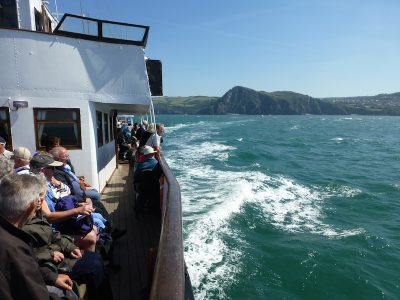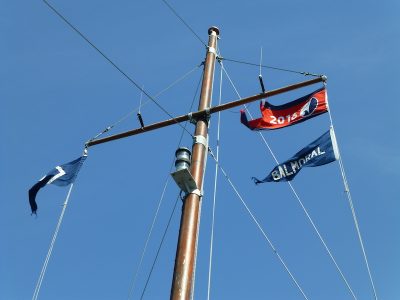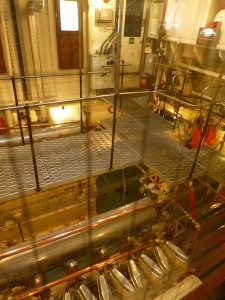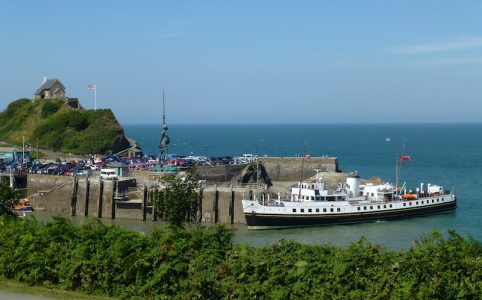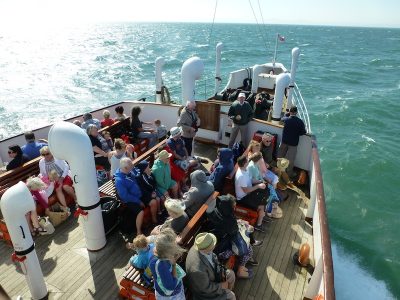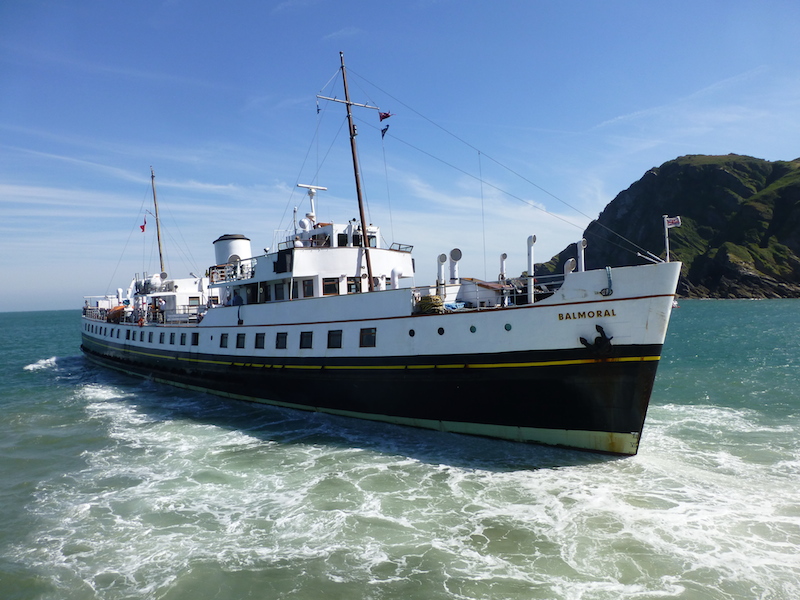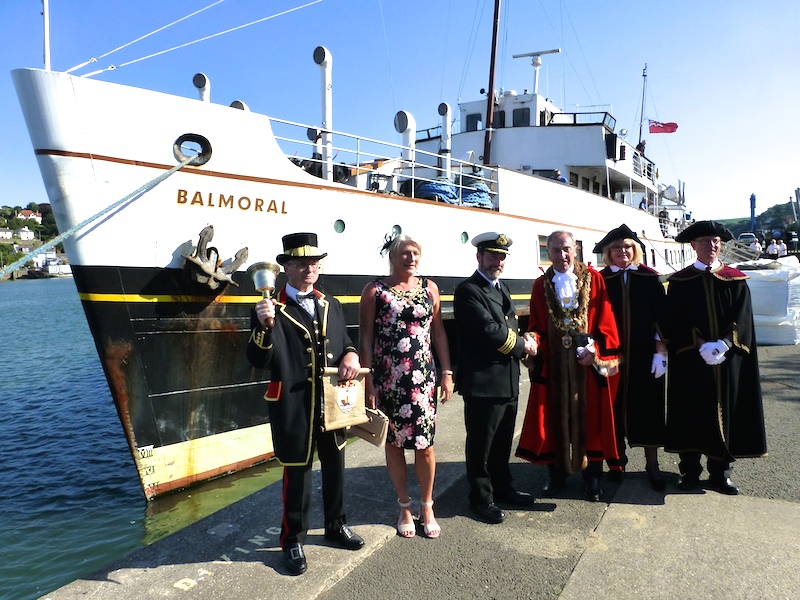
Welcome to Bideford: Balmoral’s visit on 12 August 2016 was her first for many years, prompting the Lord and Lady Mayor, the Town Crier and other local dignitaries to come out in force — copyright photo Richard Coton/CRSC
As Balmoral prepares to visit the Clyde for four days of sailings over the September weekend, Richard Coton extols the charms of the classic motor ship, fresh from a cruise along the North Devon coast.
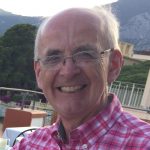 I’ve always had a soft spot for Balmoral. I first sailed on her in Red Funnel days, in 1966. She was immaculately maintained: you could have eaten your breakfast off her decks. She was beautifully designed: generous open decks above and tidy little lounges below.
I’ve always had a soft spot for Balmoral. I first sailed on her in Red Funnel days, in 1966. She was immaculately maintained: you could have eaten your breakfast off her decks. She was beautifully designed: generous open decks above and tidy little lounges below.
But as she pottered languidly (and pretty emptily) around the piers of the eastern Solent, she wasn’t exactly fulfilling her potential. We were on a week’s family holiday in Somerset, so two days later found us on the Bristol Channel — on an open ferry boat, to be precise, heading out into the mist from Lynmouth harbour.
Would the mist prevent us from being picked up? Had we come so far for nothing? We waited. The mist started to dissolve, and above the low headland to our right, travelling at some speed, appeared two sharply raked white funnels. The mighty Bristol Queen towered above us, passengers lining her rails as our ferryboat edged alongside the steps descending from the aft sponson. She slowed but didn’t stop, so we battled through a creamy wake until blue jerseyed seamen reached down to lift us out of the boat. Health and Safety had yet to be invented.

Bristol Queen at Hotwells Landing Stage, Bristol, on 9 September 1962 — copyright photo CRSC Dr Joe McKendrick Collection
Bristol Queen was the complete opposite of Balmoral. She was an enthusiast’s ship par excellence. You could roam her decks from the bow post to stern platform; no railed off rope handling areas on her. She was exciting; driven hard, it was more like being on Duchess of Hamilton than anything else.
But she was an operational nightmare. Just a few weeks into the season, and an ominous knock sounded from the engine room at every turn of the paddles. The decks had been coated in some sort of dark varnish which was now pealing off. Crowds enjoyed the sun that day, but if it rained they would have to retreat to the dark, cavernous halls of the main deck.
I still remember eating dried out fish and chips with peas like pellets in the dining saloon, unable to see the stunning scenery through a porthole.
No, in truth, what the White Funnel Fleet needed was a smart motor ship operated amidst that stunning scenery with all the flare of Bristol Queen — but with better facilities and much, much lower overheads. If there wasn’t urgent action, the Bristol Channel would be lost to cruising for ever. Now where on earth could a suitable ship be found?
Fast forward exactly 50 years. I would never have dared to predict that I’d again be cruising beneath those awesome North Devon cliffs on an immaculately maintained White Funnel ship — MV Balmoral.
Yesterday we enjoyed a fascinating triangular cruise from Penarth (Cardiff’s coastal suburb) and Clevedon (with its beautiful Victorian cast iron pier) to the tiny Somerset harbour of Watchet.
But today is the icing on the cake. We start with a two-hour trip right across the Bristol Channel’s blue waters from Swansea, our decks full of people enjoying the warm sunshine, bows cutting through the white horses.
Then we sweep into Ilfracombe, perhaps the most spectacular approach to any UK pier, beneath those towering cliffs. There’s time ashore to explore the quaint harbour, before we’re off along the cliff-bound North Devon coast to Bideford Bay and the mouth of the River Torridge.
There, after picking up a pilot and passing the village of Appledore (where the CalMac ferries Clansman and Coruisk were built), we thread our way for four miles up the narrow channel to Bideford, a picturesque and once-prosperous port that is now accessible only under certain tidal conditions.
On our return, dolphins play in our wake and the moon makes a silver pathway across the waves.
Three things strike you about Balmoral. Firstly, she is just as much a celebrity on the Bristol Channel as Waverley is on the Clyde. At Bideford, we are greeted by the Mayor and his entourage in full regalia. At Ilfracombe, the Town Crier sees us off.
Secondly, Balmoral breathes tradition, and she has a particularly interesting pedigree. Like Waverley she replaced a previous fleet flagship of the same name, in her case an outstanding paddle steamer from 1900, designed for cross-Channel excursions from Bournemouth and the Solent.
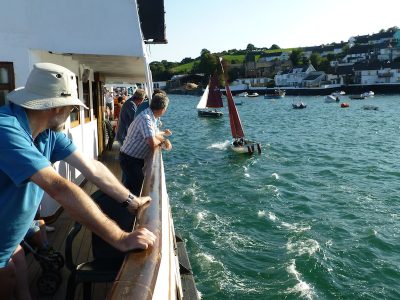
Balmoral weaves her way past sailing dinghies in the narrow River Torridge — copyright photo Richard Coton/CRSC
But an extra two years were spent to develop a design derived from the coastal paddle steamer, yet well adapted for post-war conditions. In the early stages of the design process, it was planned to give her two 8-cylinder engines permitting a speed of 18 knots on long-haul and cross-channel excursions, but Red Funnel eventually settled on lighter 6-cylinder engines which made Balmoral a highly flexible coastal ‘steamer’.
She was suitable for any pier, for excursions within Class III and IV limits, for tendering Atlantic liners and, with her car deck at the stern, for regular use on the Southampton-Cowes ferry. With twin rudders and widely spaced propellers, she is highly manoeuvrable and has the same ability as a paddler to speed up to a pier and suddenly stop.
The third thing that strikes you is the atmosphere aboard: Balmoral exudes enthusiasm and friendliness. You notice it from the moment you arrive at a pier and see the volunteer ‘pier hosts’ with their dayglow jackets emblazoned “Ask me about Balmoral”.
Dick Clague, Balmoral’s National Volunteer Coordinator, was on hand to tell me they have 60-70 volunteers spread around the coasts — absolutely essential for the 55 separate ports of call scheduled this season.
The enthusiasm spreads to the full-time crew. Relief Master Ian Henderson welcomed me to the bridge. He had been on the Caspian Sea when he got the call to help out with Balmoral for a month. Based in Glasgow, he did a couple of years on the CalMac ‘streakers’, and claims the speed record for Saturn (13.3 knots astern — it turns out she could go a full knot faster backwards than she could forwards!). First Officer at the moment is Roy Skucek, a port pilot from Wellington, New Zealand, who has volunteered for a couple of weeks while visiting family in Wales.
Balmoral needs all the volunteering and enthusiastic support she can get. Bought for £1 by a new charity (MV Balmoral Fund) from Waverley Steam Navigation Ltd, she defied the odds by returning to service for a short 2015 season, and this year is revisiting all her old haunts around our coasts — including of course the Clyde (September 23-26). Passenger numbers overall have been buoyant — the demand for coastal cruising definitely persists. Yes, she has lost 15% of sailings to the weather, but that was actually budgeted for (the Bristol Channel is notoriously exposed). But what has challenged the fledgling company’s finances has been the loss of a number of sailings during the early season due to strong winds and problems with a bearing on one of the prop shafts.
So when Balmoral visits the Clyde this September, don’t miss sailing on her. And bring your friends and family too. She’s a national treasure that we need to keep; deservedly, she is the 2016 Flagship of our National Historic Ships.
And she’s exciting. The final word (predictably enthusiastic) belongs to Captain Henderson: “She’s like a destroyer. She’s got fine lines and really cuts through the water. She’s immensely manoeuvrable.” He pauses, then adds with a twinkle in his eye, “When she’s running at 15-16 knots, you could put her well over to port or starboard and she’d lean into the turn just like a WW2 destroyer.” Not of course that any skipper of Balmoral would actually do it…..or at least, not when there are passengers on board.
After all, Balmoral came from the yard of a most successful warship builder, Thornycrofts in Southampton. She’s a thoroughbred and quite unique.
Balmoral’s Clyde season begins on September 23 with a ‘doon the watter’ trip to Rothesay and the Kyles of Bute, and ends with an ‘Arran via the Kyles’ excursion to Lochranza on September 26. Telephone: 0117 325 6200. Email: balmoral@whitefunnel.co.uk www.whitefunnel.co.uk
Richard Coton is the author of ‘A Decline of the Paddle Steamer’ (PSPS) and ‘Waverley, Last in the World’ (PSPS).
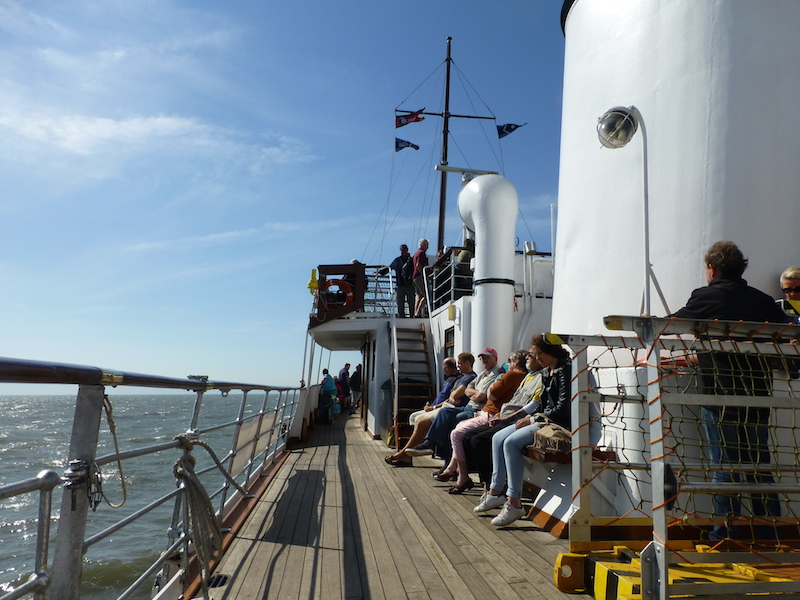
Life on the ocean wave: deck view of Balmoral looking forward on the port side — copyright photo Richard Coton/CRSC
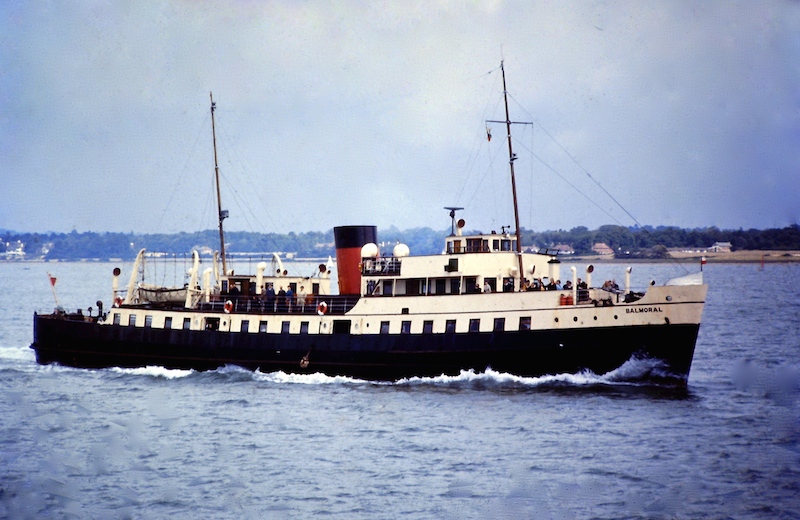
“She’s got the lines and really cuts through the water”: Balmoral in Red Funnel days — copyright CRSC Archive Collection












